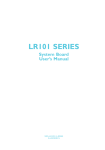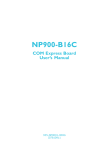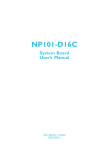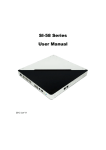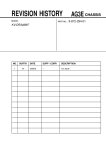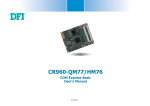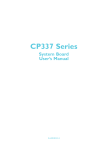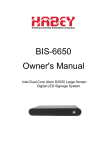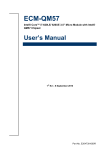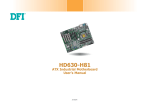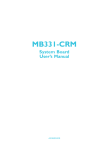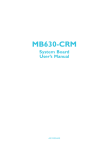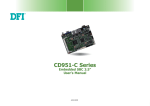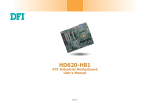Download Manual - DFI Inc.
Transcript
DS910-OT User’s Manual A20220240 Copyright This publication contains information that is protected by copyright. No part of it may be reproduced in any form or by any means or used to make any transformation/adaptation without the prior written permission from the copyright holders. This publication is provided for informational purposes only. The manufacturer makes no representations or warranties with respect to the contents or use of this manual and specifically disclaims any express or implied warranties of merchantability or fitness for any particular purpose. The user will assume the entire risk of the use or the results of the use of this document. Further, the manufacturer reserves the right to revise this publication and make changes to its contents at any time, without obligation to notify any person or entity of such revisions or changes. © 2012. All Rights Reserved. Trademarks Product names or trademarks appearing in this manual are for identification purpose only and are the properties of the respective owners. FCC and DOC Statement on Class B This equipment has been tested and found to comply with the limits for a Class B digital device, pursuant to Part 15 of the FCC rules. These limits are designed to provide reasonable protection against harmful interference when the equipment is operated in a residential installation. This equipment generates, uses and can radiate radio frequency energy and, if not installed and used in accordance with the instruction manual, may cause harmful interference to radio communications. However, there is no guarantee that interference will not occur in a particular installation. If this equipment does cause harmful interference to radio or television reception, which can be determined by turning the equipment off and on, the user is encouraged to try to correct the interference by one or more of the following measures: • • • • Reorient or relocate the receiving antenna. Increase the separation between the equipment and the receiver. Connect the equipment into an outlet on a circuit different from that to which the receiver is connected. Consult the dealer or an experienced radio TV technician for help. Notice: 1. 2. The changes or modifications not expressly approved by the party responsible for compliance could void the user’s authority to operate the equipment. Shielded interface cables must be used in order to comply with the emission limits. 1 Introduction Table of Contents Copyright ........................................................................................... 2 Trademarks ........................................................................................ 2 FCC and DOC Statement on Class B .............................................. 3 About this Manual ............................................................................. 7 Warranty .......................................................................................... 7 Static Electricity Precautions ............................................................. 8 Safety Measures ................................................................................. 8 Safety Precautions ............................................................................. 9 About the Package .......................................................................... 10 Before Using the System ................................................................. 10 Chapter 1 - Introduction ................................................................ 11 Overview ..................................................................................... 11 Key Features ............................................................................... 12 Specifications ................................................................................ 13 Getting to Know the DS910-OT .................................................... 15 Mechanical Dimensions ................................................................. 17 Chapter 2 - Getting Started ........................................................... 18 Preparing the System .................................................................... 18 Installing Devices ......................................................................... 18 Configuring BIOS .......................................................................... 18 Installing the Operating System ...................................................... 18 Installing the Drivers ..................................................................... 19 4 Introduction Chapter 3 - Installing Devices 1 ........................................................ 20 Removing the Chassis Cover ......................................................... 20 Installing a SODIMM ..................................................................... 22 Installing a SATA Drive .................................................................. 24 Connecting Cables to Terminal Blocks ............................................ 27 Chapter 4 - Jumper Settings ........................................................... 28 Clear CMOS Data ........................................................................ 28 USB Power Select ......................................................................... 29 mSATA/Mini PCIe Select ................................................................ 30 COM1 RS232/ Power Select .......................................................... 31 COM1 RS232/RS422/RS485 Select ................................................. 32 Power-on Select............................................................................ 33 Chapter 5 - Ports and Connectors ................................................ 34 Front Panel I/O Ports.................................................................... 34 COM Port ................................................................................ 35 Digital Input/Output ................................................................. 36 USB Ports................................................................................ 37 SD/MMC.................................................................................. 38 Rear Panel I/O Ports ..................................................................... 39 LAN Port ................................................................................. 40 USB Ports................................................................................ 41 Line-out .................................................................................. 42 DVI-I ...................................................................................... 43 HDMI ...................................................................................... 44 I/O Connectors ............................................................................ 45 Mini PCIe Slot .......................................................................... 45 Front Panel Connectors ............................................................. 46 LEDs....................................................................................... 47 Cooling Fan Connectors............................................................. 48 Chassis Intrusion Connector ...................................................... 49 Battery ................................................................................... 50 SATA (Serial ATA) Connector ..................................................... 51 HDD Power.............................................................................. 52 Factory Testing ........................................................................ 53 5 1 Introduction Chapter 6 - Mounting Options ....................................................... 54 Wall Mounting ............................................................................. 54 VESA Mounting ............................................................................55 Chapter 7 - BIOS Setup .................................................................. 57 Overview .............................................................................................................. 57 AMI BIOS Setup Utility ................................................................. 59 Main ....................................................................................... 59 Advanced ................................................................................ 60 Chipset ................................................................................... 70 Boot ....................................................................................... 78 Security .................................................................................. 80 Save & Exit ............................................................................. 81 Updating the BIOS ........................................................................ 82 Chapter 8 - Supported Software .................................................... 83 Appendix A - NLITE and AHCI Installation Guide ....................... 102 Appendix B - Watchdog Sample Code ......................................... 114 Appendix C - System Error Message............................................ 117 Appendix D - Troubleshooting ...................................................... 119 6 Introduction 1 About this Manual An electronic file of this manual is included in the DVD. To view the user’s manual in the DVD, insert the DVD into a DVD-ROM drive. The autorun screen (Main Board Utility CD) will appear. Click “User’s Manual” on the main menu. Warranty 1. Warranty does not cover damages or failures that arised from misuse of the product, inability to use the product, unauthorized replacement or alteration of components and product specifications. 2. The warranty is void if the product has been subjected to physical abuse, improper installation, modification, accidents or unauthorized repair of the product. 3. Unless otherwise instructed in this user’s manual, the user may not, under any circumstances, attempt to perform service, adjustments or repairs on the product, whether in or out of warranty. It must be returned to the purchase point, factory or authorized service agency for all such work. 4. We will not be liable for any indirect, special, incidental or consequencial damages to the product that has been modified or altered. 7 1 Introduction Static Electricity Precautions It is quite easy to inadvertently damage your PC, system board, components or devices even before installing them in your system unit. Static electrical discharge can damage computer components without causing any signs of physical damage. You must take extra care in handling them to ensure against electrostatic build-up. 1. To prevent electrostatic build-up, leave the system board in its anti-static bag until you are ready to install it. 2. Wear an antistatic wrist strap. 3. Do all preparation work on a static-free surface. 4. Hold the device only by its edges. Be careful not to touch any of the components, contacts or connections. 5. Avoid touching the pins or contacts on all modules and connectors. Hold modules or connectors by their ends. Important: Electrostatic discharge (ESD) can damage your processor, disk drive and other components. Perform the upgrade instruction procedures described at an ESD workstation only. If such a station is not available, you can provide some ESD protection by wearing an antistatic wrist strap and attaching it to a metal part of the system chassis. If a wrist strap is unavailable, establish and maintain contact with the system chassis throughout any procedures requiring ESD protection. Safety Measures To avoid damage to the system: • Use the correct AC input voltage range. To reduce the risk of electric shock: • Unplug the power cord before removing the system chassis cover for installation or servicing. After installation or servicing, cover the system chassis before plugging the power cord. Battery: • Danger of explosion if battery incorrectly replaced. • Replace only with the same or equivalent type recommend by the manufacturer. • Dispose of used batteries according to local ordinance. 8 Introduction 1 Safety Precautions • Use the correct AC input voltage range. • Unplug the power cord before removing the system chassis cover for installation or servicing. After installation or servicing, cover the system chassis before plugging the power cord. • Danger of explosion if battery incorrectly replaced. • Replace only with the same or equivalent type recommend by the manufacturer. • Dispose of used batteries according to local ordinance. • Keep this system away from humidity. • Place the system on a stable surface. Dropping it or letting it fall may cause damage. • The openings on the system are for air ventilation to protect the system from overheating. DO NOT COVER THE OPENINGS. • Place the power cord in such a way that it will not be stepped on. Do not place anything on top of the power cord. Use a power cord that has been approved for use with the system and that it matches the voltage and current marked on the system’s electrical range label. • If the system will not be used for a long time, disconnect it from the power source to avoid damage by transient overvoltage. • If one of the following occurs, consult a service personnel: - The power cord or plug is damaged. - Liquid has penetrated the system. - The system has been exposed to moisture. - The system is not working properly. - The system dropped or is damaged. - The system has obvious signs of breakage. • The unit uses a three-wire ground cable which is equipped with a third pin to ground the unit and prevent electric shock. Do not defeat the purpose of this pin. If your outlet does not support this kind of plug, contact your electrician to replace the outlet. • Disconnect the system from the AC outlet before cleaning. Use a damp cloth. Do not use liquid or spray detergents for cleaning. 9 1 Introduction About the Package The system package contains the following items. If any of these items are missing or damaged, please contact your dealer or sales representative for assistance. 1 DS910-OT system unit 1 HDD drive bay kit - 4 HDD screws - 1 SATA with power cable 2 Terminal blocks 1 60W power adapter - AC input: 100-240V, 50-60Hz - DC output: 12V, 5A max (60W max) 1 Quick Installation guide 1 DVD disk includes: - Drivers - Manual Optional Items 1 VESA mount kit - 1 VESA bracket - Bracket screws 1 Wallmount kit - 2 wallmount brackets - Bracket screws 1 Power cord The system and accessories in the package may not come similar to the information listed above. This may differ in accordance to the sales region or models in which it was sold. For more information about the standard package in your region, please contact your dealer or sales representative. Before Using the System Before powering-on the system, prepare the basic system components. If you are installing the system board in a new system, you will need at least the following internal components. • Storage devices such as hard disk drive, DVD-ROM, etc. You will also need external system peripherals you intend to use which will normally include at least a keyboard, a mouse and a video display monitor. 10 Introduction 1 Chapter 1 - Introduction Overview DS910-OT 11 1 Introduction Key Features DS910-OT 12 Processor AMD Chipset AMD® A50M LAN 1 LAN port COM 1 5-pole RS232 COM terminal block DIO 1 9-pole terminal block for 8-bit DIO DVI-I 1 DVI-I port USB 4 USB ports HDMI 1 HDMI port ® T40N/T56N Introduction 1 Specifications Processor • AMD® T56N (Dual-Core 1.65GHz 18W TDP) • AMD® T40N (Dual-Core 1.0GHz 9W TDP) Chipset • AMD® A50M System Memory • 2 DDR3 SODIMM sockets • Supports DDR3 1066/1333MHz (DS910-OT56N) Supports DDR3 1066MHz (DS910-OT40N) • Supports up to 16GB memory • Single channel memory interface Storage • 1 2.5" SATA drive bay • SD/MMC slot • Supports 1 mSATA module via a mini PCIe socket Graphics • Supports Hardware H.264/MPEG-4 video decoder or AVC (Advanced Video Coding) • 1080p video playback capability • DVI-I display resolution up to 1920x1080 • HDMI display resolution up to 1920x1080 • Dual display outputs - DVI-I + HDMI LAN • Realtek® RTL8111DL Gigabit Ethernet controller Audio • Realtek® ALC262 2-channel High Definition Audio COM • 1 5-pole RS232 COM terminal block Expansion • 2 mini PCIe slots - One of the slots support mSATA module 13 1 Introduction I/O Ports • Front Panel - 1 9-pole terminal block for 8-bit DIO - 1 5-pole RS232 COM terminal block - 2 USB 2.0 ports (Type A) - 1 SD/MMC slot - 1 Power LED - 1 HDD LED • Rear Panel - 1 HDMI - 1 DVI-I - 1 Line-out - 1 LAN - 2 USB 2.0 (Type A) - 1 Reset button - 1 Power button - 2 antenna holes - 12V DC-in Power • Power input voltage - +12V DC Environment • Temperature - Operating: 0oC ~ 45oC - Storage: -20oC ~ 70oC • Humidity - Operating: 10% to 85% non-condensing - Storage: 10% to 90% non-condensing Construction • Aluminum + SGCC Mounting • Wall/VESA mounting kit (brackets and screws) - optional Dimensions • 210mm x 35mm x 194.3mm (W x H x D) Weight • 1.71 kg OS Support • Windows 7, Windows 7 Embedded, Windows XP, Windows XP Embedded, Linux Kernel 2.6 Other Features • Watchdog Timer function Certification • CE • FCC Class B 14 Introduction 1 Getting to Know the DS910-OT Front Panel Power LED GPIO COM SD/MMC HDD LED USB HDD LED Indicates the status of the hard drive. Power LED Indicates the power status of the system. SD/MMC Used to insert an SD/MMC card. USB Ports Used to connect USB 2.0/1.1 devices. GPIO Port Supports 8-bit digital output and input. COM Port Used to connect serial devices. 15 1 Introduction Rear Panel Wi-Fi Module Antenna Hole HDMI LAN DVI-I Line-Out Wi-Fi Module Antenna Hole USB +12V DC-in Power Reset Wi-Fi Module Antenna Used to connect to a Wi-Fi antenna. HDMI Port Use to connect an HDMI device. DVI-I Use to connect an DVI device. Line-out Used to connect to a speaker. LAN Port Used to connect systems to a local area network. USB Ports Used to connect USB 2.0/1.1 devices. Reset Switch Press to reset the system. Power Switch Press to power-on or power-off the system. DC-in Used to plug a 12V DC. 16 Introduction 1 Mechanical Dimensions 194.30 Chassis Dimensions 210.00 35.00 35.00 17 2 Getting Started Chapter 2 - Getting Started Preparing the System Before you start using the system, you need the following items: • • • • • • SATA hard drive AC power adapter USB keyboard USB mouse CD-ROM drive (for installing software/drivers) Memory module (optional) Installing Devices The following are devices that can be installed in the DS910-OT system. • Memory module • SATA hard drive Configuring the BIOS To get you started, you may need to change configurations such as the date, time and the type of hard disk drive. 1. Power-on the system. 2. After the memory test, the message “Press DEL to run setup” will appear on the screen. Press the Delete key to enter the AMI BIOS setup utility. Installing the Operating System Most operating system software are provided in a CD therefore you need to install a CD-ROM drive in order to use the CD. Make sure a 2.5” SATA drive is already installed. 18 1. Refer to the following chapters for information on connecting a CD-ROM drive and installing a SATA drive. 2. Refer to your operating system manual for instructions on installing the operating system. Getting Started 2 Installing the Drivers The system package includes a CD disk. The CD includes drivers that must be installed to provide the best system performance. Refer to the Supported Software chapter for instructions on installing the drivers. 19 3 Installing Devices Chapter 3 - Installing Devices Removing the Chassis Cover 1. Make sure the system and all other peripheral devices connected to it has been powered-off. 2. Disconnect all power cords and cables. 3. The 8 mounting screws on the sides of the system are used to secure the cover to the chassis. Remove these screws and then put them in a safe place for later use. Mounting screw Mounting screw 20 Installing Devices 4. 3 After removing the mounting screws, lift the cover up. Lift the Cover Upward 5. The SODIMM socket and SATA drive bay are readily accessible after removing the chassis cover. SODIMM socket SATA drive bay Note: The system comes with an aluminum sheet on the heat sink. Please do not tear off. 21 3 Installing Devices Installing a SODIMM Note: The system board is equipped with two SODIMM sockets. At first, install the memory from SODIMM1. 1. Locate the SODIMM socket on the system board. SODIMM sockets 2. 22 Note the key on the socket. The key ensures the module can be plugged into the socket in only one direction. Installing Devices 3. 3 Grasping the module by its edges, align the module into the socket at an approximately 30 degrees angle. Apply firm even pressure to each end of the module until it slips down into the socket. The contact fingers on the edge of the module will almost completely disappear inside the socket. SODIMM 4. Push the module down until the clips at each end of the socket lock into position. You will hear a distinctive “click”, indicating the module is correctly locked into position. Clip Clip 23 3 Installing Devices Installing a SATA Drive 1. Remove the 4 mounting screws that secure the HDD brackets to the drive bay. Mounting screw 2. Align the mounting holes of the SATA drive with the mounting holes on the HDD bracket and then use the provided mounting screws to secure the drive in place. SATA drive HDD bracket Mounting screw Mounting screw 24 Installing Devices 3. 3 Place the SATA drive (with HDD bracket) into the chassis. Replace the 4 mounting screws you removed in step 1. Mounting screw 4. Connect the SATA data cable and SATA power cable to the connectors on the SATA drive. SATA power cable SATA data cable SATA power/data connector 25 3 Installing Devices SATA data connector SATA power connector SATA power/data connector 26 Installing Devices 3 Connecting Cables to Terminal Blocks 1. Insert one end of the cable into the holes on the terminal block, and use the screwdriver to fasten the cables. 2. Connect the terminal block to the connector on the system, and use the screwdriver to secure the terminal block in place. 27 4 Jumper Settings Chapter 4 - Jumper Settings Jumper Settings Clear CMOS Data 1 2 3 1-2 On: Normal (default) JP1 1 2 3 2-3 On: Clear CMOS Data If you encounter the following, a) CMOS data becomes corrupted. b) You forgot the supervisor or user password. you can reconfigure the system with the default values stored in the ROM BIOS. To load the default values stored in the ROM BIOS, please follow the steps below. 28 1. Power-off the system and unplug the power cord. 2. Set JP1 pins 2 and 3 to On. Wait for a few seconds and set JP1 back to its default setting, pins 1 and 2 On. 3. Now plug the power cord and power-on the system. Jumper Settings 4 USB Power Select JP5 JP6 1 2 3 1 2 3 1-2 On: +5V (default) 2-3 On: +5V_standby 3 2 1 3 2 1 2-3 On: +5V_standby 1-2 On: +5V (default) JP5 (for USB 0 and USB 1) and JP6 (for USB 2 and USB 3) are used to select the power of the USB ports. Selecting 5V_standby will allow you to use a USB device to wake up the system. BIOS Setting “USB KB Wake-Up From S3” in the Power Management Setup submenu of the BIOS must be set to Enabled. Refer to chapter 3 for more information. Important: If you are using the Wake-On-USB Keyboard/Mouse function for 2 USB ports, the 5V_standby power source of your power supply must support ≥1.5A. For 3 or more USB ports, the 5V_standby power source of your power supply must support ≥2A. 29 4 Jumper Settings mSATA/ Mini PCIe Select JP7 JP7 is used to select whether mSATA or Mini PCIe. 30 321 321 1-2 On: Mini PCIe (default) 2-3 On: mSATA Jumper Settings 4 COM1 RS232/Power Select JP9 JP9 are used to configure COM 1 to pure RS232 or RS232 with power. The pin function of COM 1 will vary according to JP9’s setting respectively. JP9 5 3 1 5 3 6 4 2 6 4 2 1-3 (RI), 2-4 (DCD) On: RS232 (default) 1 3-5 (+5V), 4-6 (+12V) On: RS232 with power 31 4 Jumper Settings COM1 RS232/RS422/RS485 Select JP8 JP8 (for COM1) is used to configure the COM port to RS232, RS422 (Full Duplex) or RS485. The pin function of the COM ports will vary according to the jumper’s setting. JP8 5 3 1 5 3 1 5 3 6 4 2 6 4 2 6 4 2 1-2 On: RS232 (default) 32 3-4 On: RS422 Full Duplex 1 5-6 On: RS485 Jumper Settings 4 Power-on Select 1 2 3 1-2 On: Power-on via power button (default) 1 2 3 JP12 2-3 On: Power-on via AC power To power-on via AC Power: 1. Set JP12 pins 2 and 3 to On. 2. Set the “After G3” field to Power On. 33 5 Ports and Connectors Chapter 5 - Ports and Connectors Front Panel I/O Ports GPIO COM USB SD/MMC The front panel I/O ports consist of the following: • • • • 34 1 1 2 1 GPIO port 5-pole RS232 COM terminal block USB SD/MMC slot Ports and Connectors 5 RIRTSGND TD DCD- COM Port 1 2 9 CTS RXD CTSDSRDTRRD COM 1 2 4 1 3 5 RTS TXD GND COM 2 COM 1 and COM 2 are fixed at RS232. COM 1’s pin definition will vary according to JP8’s settings. Refer to “COM 1 RS232/RS422/RS485 Select” in this chapter for more information. The serial ports are asynchronous communication ports with 16C550A-compatible UARTs that can be used with modems, serial printers, remote display terminals, and other serial devices. 35 5 Ports and Connectors Digital Input/Output The Digital I/O connector provides powering-on function to an external device that is connected to this connector. 36 Pin Digital Output/ Input Pin Assignment 0 DIO1 1 DIO2 2 DIO3 3 DIO4 4 DIO5 5 DIO6 6 DIO7 7 DIO8 8 GND Ports and Connectors 5 USB Ports USB 2 USB 3 USB allows data exchange between your computer and a wide range of simultaneously accessible external Plug and Play peripherals. The system board is equipped with 4 USB 2.0/1.1 ports. 37 5 Ports and Connectors SD/MMC SD/MMC This expansion port is used to insert a Secure Digital (SD) or Multimedia Card (MMC) device. Aside from storing data files, an SD card is also capable of storing powerful software applications. 38 Ports and Connectors 5 Rear Panel I/O Ports LAN HDMI DVI-I Line-Out USB The rear panel I/O ports consist of the following: • • • • • 1 1 1 1 2 HDMI port DVI-I port Line-out LAN port USB ports 39 5 Ports and Connectors LAN Port LAN The LAN port allows the system board to connect to a local area network by means of a network hub. BIOS Setting Configure “Wake on LAN” in the Advanced menu (“SuperIO Configuration” submenu) of the BIOS. Refer to chapter 7 for more information. Driver Installation Install the LAN drivers. Refer to chapter 8 for more information. 40 Ports and Connectors 5 USB Ports USB 1 USB 0 USB allows data exchange between your computer and a wide range of simultaneously accessible external Plug and Play peripherals. The system board is equipped with 4 USB 2.0/1.1 ports. 41 5 Ports and Connectors Line-out This jack is used to connect a headphone or external speakers. 42 Ports and Connectors 5 DVI-I The DVI-I port is used to connect an LCD monitor. Connect the display device’s cable connector to the DVI-I port. After you plug the cable connector into the port, gently tighten the cable screws to hold the connector in place. Connect the display device’s cable connector to the DVI-I port. After you plug the cable connector into the port, gently tighten the cable screws to hold the connector in place. BIOS Setting Configure the display device in the Advanced Chipset Features submenu of the BIOS. Refer to chapter 3 for more information. 43 5 Ports and Connectors HDMI The HDMI port which carries both digital audio and video signals is used to connect a LCD monitor or digital TV that has the HDMI port. 44 Ports and Connectors 5 I/O Connectors Mini PCIe slot Mini PCIe Install mini PCI Express cards such as network cards or other cards that comply to the mini PCI Express specifications into the mini PCI Express x1 slot. 45 5 Ports and Connectors Front Panel Connectors HDD-LED RESET-SW 11 1 12 2 PWR-LED PWR-BTN HDD-LED - HDD LED This LED will light when the hard drive is being accessed. RESET SW - Reset Switch This switch allows you to reboot without having to power off the system. PWR-BTN - Power Switch This switch is used to power on or off the system. PWR-LED - Power/Standby LED When the system’s power is on, this LED will light. When the system is in the S1 (POS - Power On Suspend) state, it will blink every second. When the system is in the S3 (STR - Suspend To RAM) state, it will blink every 4 seconds. Pin Pin Assignment N. C. 1 N. C. PWR-LED 2 4 6 HDD-LED 3 5 HDD Power Signal PWR-BTN 8 10 GND Signal RESET SW 7 9 Ground RST Signal 11 N. C. Key 12 Key N. C. 46 Pin Pin Assignment LED Power LED Power Signal Ports and Connectors 5 LEDs PWR LED HDD LED PWR LED The Power LED will light green when the system’s power is on. HDD LED The HDD LED will light yellow when the hard drive is being accessed. 47 5 Ports and Connectors Cooling Fan Connectors Sense Power Ground 3 1 System fan 2 CPU fan 1 Ground Power Sense 3 Sense Power Ground 3 1 System fan 1 The fan connectors are used to connect cooling fans. The cooling fans will provide adequate airflow throughout the chassis to prevent overheating the CPU and system board components. BIOS Setting The Advanced menu (“Hardware Health Configuration” submenu) of the BIOS will display the current speed of the cooling fan. Refer to chapter 7 for more information. 48 Ports and Connectors 5 Chassis Instrusion Connector 2 1 Ground Chassis signal The board supports the chassis intrusion detection function. Connect the chassis intrusion sensor cable from the chassis to this connector. When the system’s power is on and a chassis intrusion occurred, an alarm will sound. When the system’s power is off and a chassis intrusion occurred, the alarm will sound only when the system restarts. Hardware Monitor for Windows Install the “Hardware Monitor for Windows” utility. By default, the chassis intrusion detection function is disabled. When enabled, a warning message will appear when the chassis is open. The utility can also be configured so that a beeping alarm will sound when the chassis is open. Refer to the “Hardware Monitor for Windows” section in chapter 8 for more information. 49 5 Ports and Connectors Battery 1 Ground Battery battery Connect to the battery connector The lithium ion battery powers the real-time clock and CMOS memory. It is an auxiliary source of power when the main power is shut off. Safety Measures 50 • Danger of explosion if battery incorrectly replaced. • Replace only with the same or equivalent type recommend by the manufacturer. • Dispose of used batteries according to local ordinance. Ports and Connectors 5 SATA (Serial ATA) Connector SATA 0 GND RXP RXN GND TXN TXP GND 7 1 The Serial ATA connector is used to connect a Serial ATA device. Connect one end of the Serial ATA data cable to a SATA connector and the other end to your Serial ATA device. The system board package also comes with a power cable that must be connected from the system board to the SATA drive’s power connector in order to provide power to the drive. 51 5 Ports and Connectors HDD Power Ground Ground +12V +5V 1 HDD Power The HDD power connector supplies power to the SATA drive. Connect one end of the provided power cable to the HDD power connector and the other end to your storage device. 52 Ports and Connectors 5 Factory Testing 10 9 1 2 53 6 Mounting Options Chapter 6 - Mounting Options Wall Mounting The Wall Mounting kit includes the following: • • 2 Wallmount brackets Bracket screws 1. At the bottom side of the system, use the provided mounting screws to secure the wallmount brackets on each side of the system. Mounting screw Wallmount bracket 54 Wallmount bracket Mounting Options 6 VESA Mounting Mounting Kit • • 1 VESA bracket Bracket screws 1. Prior to installing the VESA bracket, make sure you have already installed the wallmount brackets. 2. Using the provided mouting screws, secure the VESA bracket onto the monitor 3. Align the VESA bracket to the wallmount brackets and then use the provided mounting screws to secure the bracket in place. 55 6 Mounting Options 56 75.00 100.00 100.00 75.00 BIOS Setup 3 Chapter 7 - BIOS Setup Overview The BIOS is a program that takes care of the basic level of communication between the CPU and peripherals. It contains codes for various advanced features found in this system board. The BIOS allows you to configure the system and save the configuration in a battery-backed CMOS so that the data retains even when the power is off. In general, the information stored in the CMOS RAM of the EEPROM will stay unchanged unless a configuration change has been made such as a hard drive replaced or a device added. It is possible that the CMOS battery will fail causing CMOS data loss. If this happens, you need to install a new CMOS battery and reconfigure the BIOS settings. Note: The BIOS is constantly updated to improve the performance of the system board; therefore the BIOS screens in this chapter may not appear the same as the actual one. These screens are for reference purpose only. Default Configuration Most of the configuration settings are either predefined according to the Load Optimal Defaults settings which are stored in the BIOS or are automatically detected and configured without requiring any actions. There are a few settings that you may need to change depending on your system configuration. Entering the BIOS Setup Utility The BIOS Setup Utility can only be operated from the keyboard and all commands are keyboard commands. The commands are available at the right side of each setup screen. The BIOS Setup Utility does not require an operating system to run. After you power up the system, the BIOS message appears on the screen and the memory count begins. After the memory test, the message “Press DEL to run setup” will appear on the screen. If the message disappears before you respond, restart the system or press the “Reset” button. You may also restart the system by pressing the <Ctrl> <Alt> and <Del> keys simultaneously. 57 3 BIOS Setup Legends Keys Function Right and Left arrows Moves the highlight left or right to select a menu. Up and Down arrows Moves the highlight up or down between submenus or fields. <Esc> Exits to the BIOS Setup Utility. + (plus key) Scrolls forward through the values or options of the highlighted field. - (minus key) Scrolls backward through the values or options of the highlighted field. <F1> Displays General Help. <F2> Previous Values. <F3> Optimized Defaults. <F4> Saves and exits the Setup program. <Enter> Press <Enter> to enter the highlighted submenu. Scroll Bar When a scroll bar appears to the right of the setup screen, it indicates that there are more available fields not shown on the screen. Use the up and down arrow keys to scroll through all the available fields. Submenu When ““ appears on the left of a particular field, it indicates that a submenu which contains additional options are available for that field. To display the submenu, move the highlight to that field and press <Enter>. 58 BIOS Setup 3 AMI BIOS Setup Utility Main The Main menu is the first screen that you will see when you enter the BIOS Setup Utility. Main Aptio Setup Utility - Copyright (C) 2011 American Megatrends, Inc. Advanced Chipset Save & Exit Boot Security BIOS Information BIOS Vendor Core Version Compliancy Project Version Build Date and Time American Megatrends 4.6.4.1 UEFI 2.1 OABVQ 0.15 x64 01/02/2012 12:05:12 Memory Information Total Memory 2048 MB (DDR3) System Language [English] System Date System Time [Mon 01/09/2012] [09:50:57] Access Level Administrator Choose the system default language. Select Screen Select Item Enter: Select +/-: Change Opt. F1: General Help F2: Previous Values F3: Optimized Defaults F4: Save & Exit ESC: Exit Version 2.11.1210. Copyright (C) 2011 American Megatrends, Inc. System Language Choose the system default language. System Date The date format is <day>, <month>, <date>, <year>. Day displays a day, from Sunday to Saturday. Month displays the month, from January to December. Date displays the date, from 1 to 31. Year displays the year, from 1980 to 2099. System Time The time format is <hour>, <minute>, <second>. The time is based on the 24hour military-time clock. For example, 1 p.m. is 13:00:00. Hour displays hours from 00 to 23. Minute displays minutes from 00 to 59. Second displays seconds from 00 to 59. 59 3 BIOS Setup Advanced The Advanced menu allows you to configure your system for basic operation. Some entries are defaults required by the system board, while others, if enabled, will improve the performance of your system or let you set some features according to your preference. Important: Setting incorrect field values may cause the system to malfunction. Aptio Setup Utility - Copyright (C) 2011 American Megatrends, Inc. Main Advanced Chipset Boot Legacy OpROM Support Launch PXE OpROM Launch Storage OpROM PCI Subsystem Settings ACPI Power Management Trusting Computing CPU Configuration Security [Disabled] [Enabled] Save & Exit Enable or Disable Boot Option for Legacy Network Devices. Configuration IDE Configuration USB Configuration Super IO Configuration PC Health Status Select Screen Select Item Enter: Select +/-: Change Opt. F1: General Help F2: Previous Values F3: Optimized Defaults F4: Save & Exit ESC: Exit Version 2.11.1210. Copyright (C) 2011 American Megatrends, Inc. Launch PXE OpROM Enables or disables the boot option for legacy network devices. Launch Storage OpROM Enables or disables the boot option for legacy mass storage devices with option ROM. 60 BIOS Setup 3 PCI Subsystem Settings This section is used to configure the PCI Subsystem settings. Aptio Setup Utility - Copyright (C) 2011 American Megatrends, Inc. Advanced PCI Option ROM Handling PCI ROM Priority [EFI Compatible ROM] Select the highest ACPI sleep state the system will enter, when the SUSPEND button is pressed. Select Screen Select Item Enter: Select +/-: Change Opt. F1: General Help F2: Previous Values F3: Optimized Defaults F4: Save & Exit ESC: Exit Version 2.11.1210. Copyright (C) 2011 American Megatrends, Inc. PCI ROM Priority In case multiple option ROMs exist, select the PCI option ROM to launch. 61 3 BIOS Setup ACPI Power Management Configuration This section is used to configure the ACPI Power Management. Aptio Setup Utility - Copyright (C) 2011 American Megatrends, Inc. Advanced Enables or disables BIOS ACPI Auto Configuration. ACPI Power Management Configuration Enable ACPI Auto Configuration [Disabled] ACPI Sleep State [S3 (Suspend to RAM)] Resume by PME Wake system with Fixed Time [Disabled] [Disabled] Select Screen Select Item Enter: Select +/-: Change Opt. F1: General Help F2: Previous Values F3: Optimized Defaults F4: Save & Exit ESC: Exit Version 2.11.1210. Copyright (C) 2011 American Megatrends, Inc. Enable ACPI Auto Configuration Enables or disables the ACPI function. ACPI Sleep State Selects the highest ACPI sleep state the system will enter when the Suspend button is pressed. S1(POS) Enables the Power On Suspend function. S3(STR) Enables the Suspend to RAM function. Resume by PME Enable this field to use the PME signal to wake up the system. Wake System with Fixed Time Enables or disables the system’s wake on alarm event. When enabled, the system will wake up on the specified time. 62 BIOS Setup 3 Trusted Computing (optional) This section configures settings relevant to Trusted Computing innovations. Aptio Setup Utility - Copyright (C) 2011 American Megatrends, Inc. Advanced Configuration TPM Support [Disable] Current Status Information SUPPORTED TURNED OFF Enables or Disables BIOS support for security device. O.S. will not show Security Device. TCG EFI protocol and INT1A interface will not be available. Select Screen Select Item Enter: Select +/-: Change Opt. F1: General Help F2: Previous Values F3: Optimized Defaults F4: Save & Exit ESC: Exit Version 2.14.1219. Copyright (C) 2011 American Megatrends, Inc. TPM Support Enables or Disables TPM. O.S. will not show TPM. Resetting the platform is required. 63 3 BIOS Setup CPU Configuration This section is used to configure the CPU. It will also display the detected CPU information. Aptio Setup Utility - Copyright (C) 2011 American Megatrends, Inc. Advanced CPU Configuration Node0: AMD G-T56N Processor Dual Core Running @ 1673 MHz 1350 mV Max Speed: 1650 MHz Intended Speed: 1650 MHz Limit CPUID Maximum C6 Mode [Disabled] [Enabled] Enabled for Windows XP and Linux (OS optimized for Hyper-Threading Technology) and Disabled for other OS (OS not optimized for Hyper-Threading Technology). When Disabled only one thread per enabled core is enabled. Select Screen Select Item Enter: Select +/-: Change Opt. F1: General Help F2: Previous Values F3: Optimized Defaults F4: Save & Exit ESC: Exit Version 2.11.1210. Copyright (C) 2011 American Megatrends, Inc. Limit CPUID Maximum The CPUID instruction of some newer CPUs will return a value greater than 3. The default is Disabled because this problem does not exist in the Windows series operating systems. If you are using an operating system other than Windows, this problem may occur. To avoid this problem, enable this field to limit the return value to 3 or less than 3. C6 Mode Enables or disables C6 mode. 64 BIOS Setup 3 IDE Configuration This section is used to configure the IDE. Aptio Setup Utility - Copyright (C) 2011 American Megatrends, Inc. Advanced IDE Configuration OnChip SATA Channel OnChip SATA Type [Enabled] [IDE] SATA Port 0 SATA Port 1 ST500DM002-1BD (500.1 Not Present Select Screen Select Item Enter: Select +/-: Change Opt. F1: General Help F2: Previous Values F3: Optimized Defaults F4: Save & Exit ESC: Exit Version 2.11.1210. Copyright (C) 2011 American Megatrends, Inc. OnChip SATA Channel This field is used to enable or disable the Serial ATA function. OnChip SATA Type This field is used to configure the SATA devices supported by the processor. Native IDE This option configures the Serial ATA drives as Parallel ATA storage devices. RAID This option allows you to create RAID on Serial ATA devices. AHCI This option allows the Serial ATA devices to use AHCI ( Advanced Host Controller Interface). Legacy IDE This option configures the Serial ATA drives as Legacy IDE storage devices. 65 3 BIOS Setup USB Configuration This section is used to configure USB. Aptio Setup Utility - Copyright (C) 2011 American Megatrends, Inc. Advanced USB Configuration USB Devices: 1 Keyboard, 1 Drive Legacy USB Support EHCI Hand-off [Enabled] [Disabled] USB hardware delays and time-outs: Device reset time-out [20 sec] Enables Legacy USB support. AUTO option disables legacy support if no USB devices are connected. DISABLE option will keep USB devices available only for EFI applications. Select Screen Select Item Enter: Select +/-: Change Opt. F1: General Help F2: Previous Values F3: Optimized Defaults F4: Save & Exit ESC: Exit Version 2.11.1210. Copyright (C) 2011 American Megatrends, Inc. Legacy USB Support Enabled Enables legacy USB. Auto Disables support for legacy when no USB devices are connected. Disabled Keeps USB devices available only for EFI applications. EHCI Hand-off This is a workaround for OSes that does not support EHCI hand-off. The EHCI ownership change should be claimed by the EHCI driver. Device reset time-out Selects the USB mass storage device’s start unit command timeout. 66 BIOS Setup 3 Super IO Configuration This section is used to configure the I/O functions supported by the onboard Super I/O chip. Aptio Setup Utility - Copyright (C) 2011 American Megatrends, Inc. Advanced Set parameters of Serial Port 0 (COMA). Super IO Configuration Super IO Chip Port 0 Configuration Port 1 Configuration Winbond W83627DHG Case Open Beep [Disabled] Watchdog [Disabled] AC Power Loss [Turns OFF] Serial Serial Select Screen Select Item Enter: Select +/-: Change Opt. F1: General Help F2: Previous Values F3: Optimized Defaults F4: Save & Exit ESC: Exit Version 2.11.1210. Copyright (C) 2011 American Megatrends, Inc. Case Open Beep Set this field to Enabled to allow the system to alert you of a chassis intrusion event. Watchdog This field is used to enable or disable the Watchdog Timer function. AC Power Loss Turns Off When power returns after an AC power failure, the system’s power is off. You must press the Power button to power-on the system. Turns On When power returns after an AC power failure, the system will automatically power-on. Former-Sts When power returns after an AC power failure, the system will return to the state where you left off before power failure occurs. If the system’s power is off when AC power failure occurs, it will remain off when power returns. If the system’s power is on when AC power failure occurs, the system will power-on when power returns 67 3 BIOS Setup Serial Port 0 Configuration to Serial Port 1 Configuration Aptio Setup Utility - Copyright (C) 2011 American Megatrends, Inc. Advanced Serial Port 0 Configuration Serial Port Device Settings [Enabled] IO=3F8h; IRQ=4; Change Settings [Auto] Enable or Disable Serial Port (COM) Select Screen Select Item Enter: Select +/-: Change Opt. F1: General Help F2: Previous Values F3: Optimized Defaults F4: Save & Exit ESC: Exit Version 2.11.1210. Copyright (C) 2011 American Megatrends, Inc. Aptio Setup Utility - Copyright (C) 2011 American Megatrends, Inc. Advanced Serial Port 1 Configuration Serial Port Device Settings [Enabled] IO=2F8h; IRQ=3; Change Settings [Auto] Enable or Disable Serial Port (COM) Select Screen Select Item Enter: Select +/-: Change Opt. F1: General Help F2: Previous Values F3: Optimized Defaults F4: Save & Exit ESC: Exit Version 2.11.1210. Copyright (C) 2011 American Megatrends, Inc. Serial Port Enables or disables the serial port. Change Settings Selects the IO/IRQ setting of the I/O device. 68 BIOS Setup 3 PC Health Status This section displays the SIO hardware health monitor. Aptio Setup Utility - Copyright (C) 2011 American Megatrends, Inc. Advanced PC Health Status SYSTIN temperature CPUTIN temperature CPU FAN Speed System FAN1 Speed System FAN2 Speed CPUVCore +5V +3.3V CPUVNB VDIMM +12V 3VSB VBAT : +35 C : +70 C : N/A : N/A : N/A : +1.328 V : +4.704 V : +3.344V : +3.344 V : +0.976 V : +1.552 V : +12.282 V : +3.424 V :+3.072 V Select Screen Select Item Enter: Select +/-: Change Opt. F1: General Help F2: Previous Values F3: Optimized Defaults F4: Save & Exit ESC: Exit Version 2.11.1210. Copyright (C) 2011 American Megatrends, Inc. 69 3 BIOS Setup Chipset Configures relevant chipset functions. Main North South Aptio Setup Utility - Copyright (C) 2011 American Megatrends, Inc. Advanced Boot Security Save & Exit Chipset Bridge Bridge North Bridge Parameters Select Screen Select Item Enter: Select +/-: Change Opt. F1: General Help F2: Previous Values F3: Optimized Defaults F4: Save & Exit ESC: Exit Version 2.11.1210. Copyright (C) 2011 American Megatrends, Inc. 70 BIOS Setup 3 North Bridge Aptio Setup Utility - Copyright (C) 2011 American Megatrends, Inc. Chipset North Bridge Configuration GFX Configuration Memory Information Memory Clock: 667 MHz Total Memory: 2048 MB (DDR3) GFX Configuration Memory Configuration Node 0 Information Select Screen Select Item Enter: Select +/-: Change Opt. F1: General Help F2: Previous Values F3: Optimized Defaults F4: Save & Exit ESC: Exit Version 2.11.1210. Copyright (C) 2011 American Megatrends, Inc. 71 3 BIOS Setup GFX Configuration Aptio Setup Utility - Copyright (C) 2011 American Megatrends, Inc. Chipset GFX Configuration Primary Video Device [IGD Video] NB GPP Core Config [GPP_CORE_x4x4] Select Primary Video Device that BIOS will use for output. Select Screen Select Item Enter: Select +/-: Change Opt. F1: General Help F2: Previous Values F3: Optimized Defaults F4: Save & Exit ESC: Exit Version 2.11.1210. Copyright (C) 2011 American Megatrends, Inc. Primary Video Device Select Primary Video Device that BIOS will use for output. NB GPP Core Config Selects the NB GPP Core configuration. 72 BIOS Setup 3 Memory Configuration Aptio Setup Utility - Copyright (C) 2011 American Megatrends, Inc. Chipset Memory Configuration [Auto] Integrated Graphics Enable Integrated Graphics controller. Select Screen Select Item Enter: Select +/-: Change Opt. F1: General Help F2: Previous Values F3: Optimized Defaults F4: Save & Exit ESC: Exit Version 2.11.1210. Copyright (C) 2011 American Megatrends, Inc. Integrated Graphics Enables Integrated Graphics controller. 73 3 BIOS Setup Node 0 Information Aptio Setup Utility - Copyright (C) 2011 American Megatrends, Inc. Chipset Node 0 Information Starting Address: 0 KB Ending Address: 2097151 KB Dimm0: Not Present Dimm1: size=2048 MB, speed=1333 MHZ Select Screen Select Item Enter: Select +/-: Change Opt. F1: General Help F2: Previous Values F3: Optimized Defaults F4: Save & Exit ESC: Exit Version 2.11.1210. Copyright (C) 2011 American Megatrends, Inc. 74 BIOS Setup 3 South Bridge Aptio Setup Utility - Copyright (C) 2011 American Megatrends, Inc. Chipset 1.1.1.2 SB CIM Version: SB SB Options for SB USB configurations. USB Configuration HD Azalia Configuration Select Screen Select Item Enter: Select +/-: Change Opt. F1: General Help F2: Previous Values F3: Optimized Defaults F4: Save & Exit ESC: Exit Version 2.11.1210. Copyright (C) 2011 American Megatrends, Inc. 75 3 BIOS Setup SB USB Configuration Aptio Setup Utility - Copyright (C) 2011 American Megatrends, Inc. Chipset USB USB USB USB PORT 0 PORT 1 PORT 2 PORT 3 [Enabled] [Enabled] [Enabled] [Enabled] Enable or Disable USB Port 0 Select Screen Select Item Enter: Select +/-: Change Opt. F1: General Help F2: Previous Values F3: Optimized Defaults F4: Save & Exit ESC: Exit Version 2.11.1210. Copyright (C) 2011 American Megatrends, Inc. USB Port 0 to USB Port 3 Enables or disables the selected USB port. 76 BIOS Setup 3 SB HD Azalia Configuration Aptio Setup Utility - Copyright (C) 2011 American Megatrends, Inc. Chipset HD Audio Azalia Device [Enabled] Enable or Disable HD Audio Azalia Device. Select Screen Select Item Enter: Select +/-: Change Opt. F1: General Help F2: Previous Values F3: Optimized Defaults F4: Save & Exit ESC: Exit Version 2.11.1210. Copyright (C) 2011 American Megatrends, Inc. HD Audio Azalia Device Enables or Disables HD Audio Azalia Device. 77 3 BIOS Setup Boot Aptio Setup Utility - Copyright (C) 2011 American Megatrends, Inc. Main Advanced Chipset Boot Security Save & Exit Boot Configuration Setup Prompt Timeout Bootup NumLock State 1 [On] Quiet Boot Fast Boot [Disabled] [Disabled] CSM16 Module Version 07.64 Gate A20 Active Option ROM Messages Interrupt 19 capture CSM Support [Upon Request] [Force BIOS] [Enabled] [Enabled] Boot Option Priorities Boot Option #1 Boot Option #2 [SATA PM: ST500DM0......] [Generic Storage De......] Hard Drive BBS Priorities USB device BBS Priorities Number of seconds to wait for setup activation key. 65535(0xFFFF) means indefinite waiting. Select Screen Select Item Enter: Select +/-: Change Opt. F1: General Help F2: Previous Values F3: Optimized Defaults F4: Save & Exit ESC: Exit Version 2.11.1210. Copyright (C) 2011 American Megatrends, Inc. Setup Prompt Timeout Selects the number of seconds to wait for the setup activation key. 65535(0xFFFF) denotes indefinite waiting. Bootup NumLock State This allows you to determine the default state of the numeric keypad. By default, the system boots up with NumLock on wherein the function of the numeric keypad is the number keys. When set to Off, the function of the numeric keypad is the arrow keys. Quiet Boot Enables or disables the quiet boot function. Fast Boot Enables or disables boot with initialization of a minimal set of devices re quired to launch active boot option. Has no effect for BBS boot options. GateA20 Active Upon Request- GA20 can be disabled using BIOS services. Alwasy- Do not allow disabling GA20; this option is useful when any RT code is executed above 1MB. 78 BIOS Setup 3 Option ROM Messages Set display mode for option ROM. Interrupt 19 Capture Enabled: Allows option ROMs to trap Int 19. Disabled: CSM Support Enabled/ disabled CSM support. If auto is selected, based on OS, CSM will be enabled/ disabled automatically. Boot Option #1 and Boot Option #2 Selects the boot sequence of the device. 79 3 BIOS Setup Security Aptio Setup Utility - Copyright (C) 2011 American Megatrends, Inc. Main Advanced Chipset Boot Security Set Setup Administrator Password Password Description If ONLY the Administrator’s password is set, then this only limits access to Setup and is only asked for when entering Setup. If ONLY the User’s password is set, then this is a power on password and must be entered to boot or enter Setup. In Setup the User will have Administrator rights. The password length must be in the following range: Minimun length Maximun length Administrator Password User Password HDD Security Configuration: HDD 0: ST500DM002-1 Save & Exit 3 20 Select Screen Select Item Enter: Select +/-: Change Opt. F1: General Help F2: Previous Values F3: Optimized Defaults F4: Save & Exit ESC: Exit Version 2.11.1210. Copyright (C) 2011 American Megatrends, Inc. Administrator Password Sets the administrator password. User Password Sets the user password. 80 BIOS Setup 3 Save & Exit Aptio Setup Utility - Copyright (C) 2011 American Megatrends, Inc. Main Advanced Chipset Boot Save Changes and Reset Discard Changes and Reset Security Save & Exit Reset the system after saving the changes. Save Options Save Changes Discard Changes Restore Defaults Save as User Defaults Restore User Defaults Boot Override Generic Storage Device 9454 Launch EFI Shell from file system device Select Screen Select Item Enter: Select +/-: Change Opt. F1: General Help F2: Previous Values F3: Optimized Defaults F4: Save & Exit ESC: Exit Version 2.11.1210. Copyright (C) 2011 American Megatrends, Inc. Save Changes and Reset To save the changes, select this field and then press <Enter>. A dialog box will appear. Select Yes to reset the system after saving all changes made. Discard Changes and Reset To discard the changes, select this field and then press <Enter>. A dialog box will appear. Select Yes to reset the system setup without saving any changes. Restore Defaults To restore and load the optimized default values, select this field and then press <Enter>. A dialog box will appear. Select Yes to restore the default values of all the setup options. Save as User Defaults To save changes done so far as user default, select this field and then press <Enter>. A dialog box will appear. Select Yes to save values as user default. Restore User Defaults To restore user default to all the setup options, select this field and then press <Enter>. A dialog box will appear. Select Yes to restore user default. 81 3 BIOS Setup Updating the BIOS To update the BIOS, you will need the new BIOS file and a flash utility, AFUDOS. EXE. Please contact technical support or your sales representative for the files. To execute the utility, type: A:> AFUDOS BIOS_File_Name /b /p /n then press <Enter>. C:\AFU\AFUDOS>afudos filename /B /P /N +--------------------------------------------------------------------------------------------------------+ | AMI Firmware Update Utility(APTIO) v2.25 | Copyright (C)2008 American Megatrends Inc. All Rights Reserved. +--------------------------------------------------------------------------------------------------------+ Reading file .............................. Erasing flash ............................. Writing flash ............................. Verifying flash .......................... Erasing BootBlock .................... Writing BootBlock .................... Verifying BootBlock ................. C:\AFU\AFUDOS> 82 done done done done done done done | | Supported Software 8 Chapter 8 - Supported Software The CD that came with the board contains drivers, utilities and software applications required to enhance the performance of the system board. Insert the CD into a CD-ROM drive. The autorun screen (Mainboard Utility CD) will appear. If after inserting the CD, “Autorun” did not automatically start, please go directly to the root directory of the CD and double-click “Setup”. 83 8 Supported Software Microsoft .NET Framework 3.5 (for Windows XP only) Note: Before installing Microsoft .NET Framework 3.5, make sure you have updated your Windows XP operating system to Service Pack 3. To install the driver, click “Microsoft .NET Framework 3.5” on the main menu. 1. Read the license agreement carefully. Click “I have read and accept the terms of the License Agreement” then click Install. 2. 84 Setup is now installing the driver. Supported Software 3. 8 Click Exit. 85 8 Supported Software AMD Embedded GPU and Chipset Software Installation Utility To install the driver, click “AMD Embedded GPU and Chipset Software Installation Utility” on the main menu. 86 1. Under the Language Support section, select the language you would like the installation to display and then click Next.. 2. Click Install to begin the installation. Supported Software 3. Click Express and then click Next. 4. After completing installation, click Finish. 8 87 8 Supported Software Microsoft DirectX 9.0C (for Windows XP only) To install the driver, click “Microsoft DirectX 9.0C” on the main menu. 88 1. Click “I accept the agreement” then click Next. 2. To start installation, click Next. 3. Click Finish. Reboot the system for DirectX to take effect. Supported Software 8 Audio Drivers To install the driver, click “Audio Drivers” on the main menu. 1. Setup is now ready to install the audio driver. Click Next. 2. Follow the remainder of the steps on the screen; clicking “Next” each time you finish a step. 3. Click “Yes, I want to restart my computer now” then click Finish. Restarting the system will allow the new software installation to take effect. 89 8 Supported Software Realtek LAN Drivers To install the driver, click “Realtek LAN Drivers” on the main menu. 90 1. Setup is ready to install the driver. Click Next. 2. Click Install to begin the installation. 3. After completing installation, click Finish. Supported Software 8 Hardware Doctor To install the driver, click “Hardware Doctor” on the main menu. 1. Setup is ready to install the driver. Click Next. 2. Click Next to install to this folder, or click Change to install to a different folder. 91 8 92 Supported Software 3. Click Install to begin the installation. 4. After completing installation, click Finish. Supported Software 8 DFI Utility DFI Utility provides information about the board, Watchdog, DIO, and Backlight. To access the utility, click “DFI Utility” on the main menu. Note: If you are using Windows 7, you need to access the operating system as an administrator to be able to install the utility. 1. Setup is ready to instal the DFI Utility driver Click “Next”. 2. Click “I accept the terms in the license agreement” then click “Next”. 93 8 Supported Software 3. Enter “User name” and “Organization” information then click “Next”. 4. Click “Install” to begin the installation. 5. After completing installa tion, click “Finish”. 94 Supported Software 8 The DFI Utility icon will appear on the desktop. Double-click the icon to open the utility. 95 8 Supported Software F6 Floppy Configuration Utility This is used to create a floppy driver diskette needed when you install Windows® XP using the F6 installation method. This will allow you to install the operating system onto a hard drive when in AHCI mode. 1. Insert a blank floppy diskette. 2. Locate for the drivers in the CD then copy them to the floppy diskette. The CD includes drivers for both 32-bit and 64-bit operating systems. The path to the drivers are shown below. 32-bit CD Drive:\AHCI_RAID\F6FLOPPY\f6flpy32 64-bit CD Drive:\AHCI_RAID\F6FLOPPY\f6flpy64 96 Supported Software 8 Intel TPM Driver and Tool (option) To install the driver, click “Infineon TPM driver and tool (option)” on the main menu. 1. TPM requires installing the Microsoft Visual C++ package prior to installing the driver. Click Install. 2. The setup program is preparing to install the driver. 3. The setup program is ready to install the driver. Click Next. 97 8 98 Supported Software 4. Click “I accept the terms in the license agreement” and then click “Next”. 5. Enter the necessary information and then click Next. 6. Select a setup type and then click Next. Supported Software 7. Click Install. 8. The setup program is currently installing the driver. 9. Click Finish. 8 99 8 Supported Software 10. Click Yes to restart the system. Restarting the system will allow the new software installation to take effect. 100 Supported Software 8 Adobe Acrobat Reader 9.3 To install, click “Adobe Acrobat Reader 9.3” on the main menu. 1. Click Next to install to the destination folder or click Change Destination folder to select another folder. 2. Click Install to begin installation. 3. Click Finish to exit installaion. 101 A NLITE and AHCI Installation Guide Appendix A - NLITE and AHCI Installation Guide nLite nLite is an application program that allows you to customize your XP installation disc by integrating the RAID/AHCI drivers into the disc. By using nLite, the F6 function key usually required during installation is no longer needed. Note: The installation steps below are based on nLite version 1.4.9. Installation procedures may slightly vary if you’re using another version of the program. 1. Download the program from nLite’s offical website. http://www.nliteos.com/download.html 2. Install nLite. Important: Due to it’s coding with Visual.Net, you may need to first install .NET Framework prior to installing nLite. 3. Download relevant RAID/AHCI driver files from Intel’s website. The drivers you choose will depend on the operating system and chipset used by your computer. The downloaded driver files should include iaahci.cat, iaAHCI.inf, iastor.cat, iaStor. inf, IaStor.sys, license.txt and TXTSETUP.OEM. 102 NLITE and AHCI Installation Guide 4. Insert the XP installation disc into an optical drive. 5. Launch nLite. The Welcome screen will appear. Click Next. 6. Click Next to temporarily save the Windows installation files to the designated default folder. A If you want to save them in another folder, click Browse, select the folder and then click Next. 103 A 104 NLITE and AHCI Installation Guide 7. Click Next. 8. In the Task Selection dialog box, click Drivers and Bootable ISO. Click Next. NLITE and AHCI Installation Guide 9. 10. A Click Insert and then select Multiple driver folder to select the drivers you will integrate. Click Next. Select only the drivers appropriate for the Windows version that you are using and then click OK. Integrating 64-bit drivers into 32-bit Windows or vice versa will cause file load errors and failed installation. 105 A 106 NLITE and AHCI Installation Guide 11. If you are uncertain of the southbridge chip used on your motherboard, select all RAID/AHCI controllers and then click OK. 12. Click Next. NLITE and AHCI Installation Guide 13. The program is currently integrating the drivers and applying changes to the installation. 14. When the program is finished applying the changes, click Next. A 107 A NLITE and AHCI Installation Guide 15. To create an image, select the Create Image mode under the General section and then click Next. 16. Or you can choose to burn it directly to a disc by selecting the Direct Burn mode under the General section. Select the optical device and all other necessary settings and then click Next. 108 NLITE and AHCI Installation Guide 17. A You have finished customizing the Windows XP installation disc. Click Finish. Enter the BIOS utility to configure the SATA controller to RAID/AHCI. You can now install Windows XP. 109 A NLITE and AHCI Installation Guide AHCI The installation steps below will guide you in configuring your SATA drive to AHCI mode. 1. Enter the BIOS utility and configure the SATA controller to IDE mode. 2. Install Windows XP but do not press F6. 3. Download relevant RAID/AHCI driver files supported by the motherboard chipset from Intel’s website. Transfer the downloaded driver files to C:\AHCI. 4. Open Device Manager and right click on one of the Intel Serial ATA Storage Controllers, then select Update Driver. If the controller you selected did not work, try selecting another one. 110 NLITE and AHCI Installation Guide 5. In the Hardware Update Wizard dialog box, select “No, not this time” then click Next. 6. Select “Install from a list or specific location (Advanced)” and then click Next. 7. Select “Don’t search. I will choose the driver to install” and then click Next. A 111 A NLITE and AHCI Installation Guide 8. Click “Have Disk”. 9. Select C:\AHCI\iaAHCI.inf and then click Open. 10. 112 Select the appropriate AHCI Controller of your hardware device and then click Next. NLITE and AHCI Installation Guide 11. A A warning message appeared because the selected SATA controller did not match your hardware device. Ignore the warning and click Yes to proceed. 12. Click Finish. 13. The system’s settings have been changed. Windows XP requires that you restart the computer. Click Yes. 14. Enter the BIOS utility and modify the SATA controller from IDE to AHCI. By doing so, Windows will work normally with the SATA controller that is in AHCI mode. 113 B Watchdog Timer Appendix B - Watchdog Timer Watchdog Timer The following parameters are references for setting the time interval of the Watchdog Timer function. The system will regularly be “cleared” according to the set time interval. If the system hangs or fails to function, it will also reset according to the time interval so that your system will continue to operate. .model small .386 ;------------------;Port defination ;------------------SuperIo_CFG_Port EQU SuperIo_DAT_Port EQU 2Eh ;Super I/O Config port. (2Eh/4Eh) SuperIo_CFG_Port + 1 WDT_Counter 10 EQU ; 1 to 255 (Sec./Min), 0 means disabled mSuperio_Enter_Config Macro mov dx, SuperIo_CFG_Port mov al, 87h out dx, al NEWIODELAY out dx, al endM mSuperio_Exit_Config Macro mov dx, SuperIo_CFG_Port mov al, 0AAh out dx, al endM mSuperio_GetSet_Reg Macro RegIndex, AndMask, OrValue mov dx, SuperIo_CFG_Port mov al, RegIndex out dx, al NEWIODELAY mov dx, SuperIo_DAT_Port in al, dx NEWIODELAY mov ah, al and al, AndMask or al, OrValue out dx, al NEWIODELAY endM mSuperio_Get_Reg Macro RegIndex mov dx, SuperIo_CFG_Port mov al, RegIndex out dx, al 114 Watchdog Timer B NEWIODELAY mov dx, SuperIo_DAT_Port in al, dx NEWIODELAY endM mSuperio_LDN_Select Macro LDN mSuperio_Set_Reg 07h, LDN endM mSuperio_Set_Reg Macro RegIndex, SetValue mov dx, SuperIo_CFG_Port mov al, RegIndex out dx, al NEWIODELAY mov dx, SuperIo_DAT_Port mov al, SetValue out dx, al NEWIODELAY endM NEWIODELAY out endM Macro 0EBh, al ;Dummy I/O output for delay .code start: call mov int W83627Hx_WDT ah, 4ch 21h W83627Hx_WDT Proc near ;LDN8 ;CRF5[3] :RW 0/1 = WDTO Second/Minute ;CRF5[2] :RW 0/1 = Keyboard Reset Low/High when WDTO Timeout ;CRF6[7:0]:RW 00h = Disable , 01h~0FFh = 1~255 Sec/Min. ;CRF7[7] :RW 0/1 = Disable/Enable Mouse interrupt reset WDTO counting. ;CRF7[6] :RW 0/1 = Disable/Enable Keyboard interrupt reset WDTO counting. ;CRF7[5] :WO 1 = Force WDTO time out(Auto clear). ;CRF7[4] :RW 0/1 = WDTO time status TimeOut/Counting. ;CRF7[3:0]:RW 0~7 = Low IRQ for WDTO (Typical is 2, means SMI). mSuperio_Enter_Config mSuperio_LDN_Select 08h 115 B Watchdog Timer ; PLED mode register, WDTO time unit as second, Keyboard reset when WDTO time out mSuperio_GetSet_Reg 0F5h, 11110111b, 00000100b ; , Disable MS/KB interrupt reset WDTO counting, IRQ2 for WDTO mSuperio_GetSet_Reg 0F7h, 11111111b, 11000010b ; , WDTO Time out Value mSuperio_Set_Reg 0F6h, WDT_Counter mSuperio_Exit_Config @@: ret W83627Hx_WDT end start 116 endP System Error Message C Appendix C - System Error Message When the BIOS encounters an error that requires the user to correct something, either a beep code will sound or a message will be displayed in a box in the middle of the screen and the message, PRESS F1 TO CONTINUE, CTRL-ALT-ESC or DEL TO ENTER SETUP, will be shown in the information box at the bottom. Enter Setup to correct the error. Error Messages One or more of the following messages may be displayed if the BIOS detects an error during the POST. This list indicates the error messages for all Awards BIOSes: CMOS BATTERY HAS FAILED The CMOS battery is no longer functional. It should be replaced. Important Danger of explosion if battery incorrectly replaced. Replace only with the same or equivalent type recommended by the manufacturer. Dispose of used batteries according to the battery manufacturer’s instructions. CMOS CHECKSUM ERROR Checksum of CMOS is incorrect. This can indicate that CMOS has become corrupt. This error may have been caused by a weak battery. Check the battery and replace if necessary. DISPLAY SWITCH IS SET INCORRECTLY The display switch on the motherboard can be set to either monochrome or color. This indicates the switch is set to a different setting than indicated in Setup. Determine which setting is correct, either turn off the system and change the jumper or enter Setup and change the VIDEO selection. Hard Disk(s) fail (80) HDD reset failed. Hard Disk(s) fail (40) HDD controller diagnostics failed. 117 C System Error Message Hard Disk(s) fail (20) HDD initialization error. Hard Disk(s) fail (10) Unable to recalibrate fixed disk. Hard Disk(s) fail (08) Sector Verify failed. Keyboard is locked out - Unlock the key The BIOS detects that the keyboard is locked. Keyboard controller is pulled low. Keyboard error or no keyboard present Cannot initialize the keyboard. Make sure the keyboard is attached and no keys are being pressed during the boot. correctly Manufacturing POST loop System will repeat POST procedure infinitely while the keyboard controller is pull low. This is also used for the M/B burn in test at the factory. BIOS ROM checksum error - System halted The checksum of ROM address F0000H-FFFFFH is bad. Memory test fail The BIOS reports memory test fail if the memory has error(s). 118 Troubleshooting D Appendix D - Troubleshooting Troubleshooting Checklist This chapter of the manual is designed to help you with problems that you may encounter with your personal computer. To efficiently troubleshoot your system, treat each problem individually. This is to ensure an accurate diagnosis of the problem in case a problem has multiple causes. Some of the most common things to check when you encounter problems while using your system are listed below. 1. The power switch of each peripheral device is turned on. 2. All cables and power cords are tightly connected. 3. The electrical outlet to which your peripheral devices are connected is working. Test the outlet by plugging in a lamp or other electrical device. 4. The monitor is turned on. 5. The display’s brightness and contrast controls are adjusted properly. 6. All add-in boards in the expansion slots are seated securely. 7. Any add-in board you have installed is designed for your system and is set up correctly. Monitor/Display If the display screen remains dark after the system is turned on: 1. Make sure that the monitor’s power switch is on. 2. Check that one end of the monitor’s power cord is properly attached to the monitor and the other end is plugged into a working AC outlet. If necessary, try another outlet. 3. Check that the video input cable is properly attached to the monitor and the system’s display adapter. 4. Adjust the brightness of the display by turning the monitor’s brightness control knob. 119 D Troubleshooting The picture seems to be constantly moving. 1. The monitor has lost its vertical sync. Adjust the monitor’s vertical sync. 2. Move away any objects, such as another monitor or fan, that may be creating a magnetic field around the display. 3. Make sure your video card’s output frequencies are supported by this monitor. The screen seems to be constantly wavering. 1. If the monitor is close to another monitor, the adjacent monitor may need to be turned off. Fluorescent lights adjacent to the monitor may also cause screen wavering. Power Supply When the computer is turned on, nothing happens. 1. Check that one end of the AC power cord is plugged into a live outlet and the other end properly plugged into the back of the system. 2. Make sure that the voltage selection switch on the back panel is set for the correct type of voltage you are using. 3. The power cord may have a “short” or “open”. Inspect the cord and install a new one if necessary. Hard Drive Hard disk failure. 1. Make sure the correct drive type for the hard disk drive has been entered in the BIOS. 2. If the system is configured with two hard drives, make sure the bootable (first) hard drive is configured as Master and the second hard drive is configured as Slave. The master hard drive must have an active/bootable partition. Excessively long formatting period. If your hard drive takes an excessively long period of time to format, it is likely a cable connection problem. However, if your hard drive has a large capacity, it will take a longer time to format. 120 Troubleshooting D Serial Port The serial device (modem, printer) doesn’t output anything or is outputting garbled characters. 1. Make sure that the serial device’s power is turned on and that the device is on-line. 2. Verify that the device is plugged into the correct serial port on the rear of the computer. 3. Verify that the attached serial device works by attaching it to a serial port that is working and configured correctly. If the serial device does not work, either the cable or the serial device has a problem. If the serial device works, the problem may be due to the onboard I/O or the address setting. 4. Make sure the COM settings and I/O address are configured correctly. Keyboard Nothing happens when a key on the keyboard was pressed. 1. Make sure the keyboard is properly connected. 2. Make sure there are no objects resting on the keyboard and that no keys are pressed during the booting process. System Board 1. Make sure the add-in card is seated securely in the expansion slot. If the add-in card is loose, power off the system, re-install the card and power up the system. 2. Check the jumper settings to ensure that the jumpers are properly set. 3. Verify that all memory modules are seated securely into the memory sockets. 4. Make sure the memory modules are in the correct locations. 5. If the board fails to function, place the board on a flat surface and seat all socketed components. Gently press each component into the socket. 6. If you made changes to the BIOS settings, re-enter setup and load the BIOS defaults. 121



























































































































